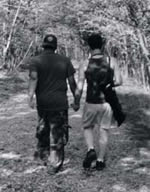
SCENE AND HEARD
by Randy Gener
 |
The Kids Stay in The Picture, Or Toward a New Queer Theatre
EDITOR'S NOTE: The following article is excerpted from Randy Gener's contribution to the book, "The Queerest Art: Essays on Lesbian and Gay Theater," published in June 2002 by New York University Press.
In School's OUT, a multi-media video and performance group for lesbian and gay youth in New York City, young urban queers get silly, smart-alecky, heavy, elegaic, and in-your-face. Breaking out of the confessional modes of commodified performance art and veering away from traditional coming-out narratives, the troupe's theatrical and video projects rip apart paternalistic media cliches about tormented adolescents, subvert cultural biases about sexuality, and throw a wrench into the works of a society that labels, circumscribes, stereotypes and pigeonholes. Bright, outspoken, and gutsy, Schools OUT members talk, leap, dance, act, and react, carving out selfscapes that tenderly portray their adolescent lives.
A project of Dance Theater Workshop's Public Imaginations program in conjunction with the Youth Enrichment Services program of the Lesbian and Gay Community Services Center, School's OUT is a watershed event in the lives of these New York City lesbian, gay, and bisexual artists of color, who range in age from 16 to 20. The program provides a supportive group experience in which its participants can deal with the process of growing up queer and explore the thistly themes in their young lives -- coming out, race, loneliness, sex, dreams and fears of the future, homophobia, racism, AIDS -- through the creation of art. The program brings queer teenagers together with professional artists to create original performances out of real-life experiences, and in some cases, to build long-term mentoring relationships.
In a country where economic, social and political constraints have conspired against the inclusion of arts education in public school curricula, School's OUT is remarkable, too, in influencing youth programs in other cities to affirm queer orientation, sexual liberty, and celebration in the face of despair and death. Though School's OUT is in touch with stark reality (suicide rates among queer teens remain high), and the project can look like social work, its primary function is to teach specific skills and to instill a professional sense of artistic craft.
Unlike other theater programs for youth-the Young Playwrights Festival, Camp Broadway or the 52nd Street Project-School's OUT is not teaching playwriting per se. The project is not interested in rearing little gay Neil Simons or perky lesbian Wendy Wassersteins. School's OUT pushes the envelope from within, along two different tracks.
From the perspective of practical sex education, it differs radically from a majority of the nation's youth programs by placing the study of sex and sexual definition in a positive context of loving relationships. The radical nature of this attitude cannot be emphasized enough: Though homosexuality may be more widely accepted in America than ever before, America continues to discuss sex primarily in terms of risk. High school sex education is usually an exercise in fear-mongering, focusing on risk and pushing condoms and abstinence, but seldom addressing the pleasure and growth young adults find in exploring their sexualities.
From a performing arts perspective, on the other hand, School's OUT actively looks for a language or shared aesthetic that shows what cannot be described by words alone. By allowing every young voice to speak in whatever medium he or she chooses, and by fostering community survival through workable consensus, School's OUT evolves a new way of looking at queer theater, one that, anachronistically perhaps, recalls the predictions of the legendary stage designer Robert Edmond Jones. Jones complained of a theater that was "strikingly out of date" in comparison to other arts, and called upon theater artists to create a new theater art by incorporating film and other developing technologies. More than half-a-century later, School's OUT is unselfconsciously answering Jones's call with its synthesis of live performance, video, and computers.
But what does it even mean to call a theater project "experimental" at the turn of the new century, especially when speaking of queer theater, when so much of the lesbian and gay work of earlier decades has yet to be acknowledged as part of even a queer repertory?
As a philosophical concept, experimentation feels quaint because it plays directly into long-held myths of unimpeded American progress. In this model, queer theater, as Charles Ludlam once said, is considered "the research-and-development department for the culture at large," a marginalized studio or lab where actors, directors, designers, and writers get to play around until they graduate into something more sophisticated. In an industry-based culture that actively seeks and takes from the cutting edge or alternative scenes in order to quickly feed (and thus neutralize) alternative practices into the maw of the mainstream machine, all the official organs of artistic power (schools, newspapers, galleries, museums, not-for-profit institutions) fall over one another to endorse, and claim credit for discovering, the new.
In today's theater, there is neither an avant garde nor a rear guard. Everyone is simply on guard. Against the futility of experimentation itself, where does an experimental queer theater position itself? [Gener]
 |
| Randy Gener |
Randy Gener is critic-at-large and a founding writer of The New York Theatre Wire. He also writes for The New York Times, The Star Ledger and American Theatre Magazine. His email is rndygener@aol.com.
 |
The Queerest Art
Edited by Alisa Solomon and Framji Minwalla
New York University Press
Cultural Studies / Pub. 7/1/2002 / 256 pages
ISBN: 0814798101 / $55.00 cloth
ISBN: 081479811X / $18.50 paper
The first anthology to bring scholars and makers of queer theater into direct dialogue, "The Queerest Art" rereads the history of performance as a celebration and critique of dissident sexualities, exploring the politics of pleasure and the pleasure of politics that drive the theater. Lively and accessible, "The Queerest Art" will be useful to scholars, students, artists, and theater-goers alike interested in what makes queer theater...and what makes theater queer.

| home | reviews |cue-to-cue |
discounts | welcome |
| museums | recordings |coupons |
classified |